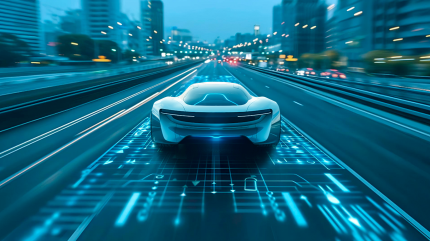
The anticipated rise of the Software-Defined Vehicle (SDV) and its transformative implications is a big talking point in the automotive industry. In an exclusive guest column for Just Auto, we hear more from Adam Konopa, Technology Director at software specialist Intellias.
The introduction of CASE (Connected, Autonomous, Shared, and Electrified) sparked a global transformation in the automotive industry, initiating a shift toward software-centric vehicles. This evolution laid the groundwork for what is now widely known as the Software-Defined Vehicle (SDV).
What began as a hardware-to-software transformation guided by the CASE framework has now evolved into a full-scale commitment to SDVs. Today, software isn’t just an add-on, it’s the driving force shaping the future of global vehicle manufacturing.
Analysts project exponential SDV market growth by 2025 driven by advances in Artificial Intelligence (AI), widespread connectivity, and above all, rising consumer demand for smart and seamlessly upgradable vehicles. Three major forces are shaping this global transformation: technical foundations, organizational transformation, and evolving market expectations.
At their core, SDVs treat software as the primary product, enabling features such as over-the-air updates, personalized in-vehicle experiences, and autonomous capabilities. But delivering on that promise requires rethinking how vehicles are engineered, from the initial concept through post-sale evolution.
SDVs also require a fundamental shift in how vehicles are designed, developed, and maintained. To support this shift, the industry is moving away from traditional Electrical/Electronic (E/E) architectures to centralized zonal systems powered by High-Performance Computers (HPCs). This shift boosts scalability while dramatically reducing system complexity.
In essence, SDVs become customizable digital platforms that evolve through cloud-driven software updates. This continuous evolution allows vehicles to be improved even after they’ve been sold, retaining, and even increasing, their value over time.
Technical foundations: Zonal architectures and HPCs
Vehicles transition to software-defined platforms replaces the legacy model, which was often built around dozens or even hundreds of discrete Electronic Control Units (ECUs), with centralized compute nodes that manage entire vehicle zones
This transition entails significant benefits: zonal architecture reduces wiring complexity by up to 30%, lowers vehicle weight, and simplify the integration of key systems such as Advanced Driver Assistance Systems (ADAS), In-Vehicle Infotainment (IVI), and telematics.
But this transformation isn’t purely technical. It demands a parallel cultural shift. Automotive development teams must increasingly adopt cross-functional, agile practices, collaborating more like tech startups than traditional manufacturing lines.
In these circumstances, software development doesn’t stop at the start-of-production (SOP). In the SDV era, software requires continuous maintenance and iterative improvements, not just across vehicle models, but across entire brand portfolios. This ongoing development cycle is essential for delivering updates, innovations, and fixes long after a vehicle hits the road.
Hardware innovation and disruptions
Next-generation automotive multi-domain System-on-Chips (SoCs) are designed to handle multiple, potentially critical workloads within a single chip. Major industry players, such as Qualcomm, NVIDIA, and Renesas, have launched flagship SoCs like Snapdragon Ride Flex, NVIDIA Drive Thor, and Renesas R-Car X5H. These chips support centralized computing platforms and advanced features like Autonomous Driving (AD), Advanced Driver-Assistance Systems (ADAS), and Digital Cockpits, including In-Vehicle Infotainment (IVI), empowering Original Equipment Manufacturers (OEMs) to develop robust SDV ecosystems. They employ isolation mechanisms to ensure that failures in one domain do not impact others. The development of such systems requires hardware-software co-design approach, offering several benefits:
- Hardware establishes the foundation for isolation, performance, and safety certification.
- Software facilitates dynamic resource management, security, and regulatory compliance.
Ultimately, without robust hardware, software cannot assure required level of safety. Therefore, the industry’s transition toward software-defined vehicles relies on advancements in both hardware and software domains.
The latest SoCs enabling high-performance, energy-efficient solutions are uniquely tailored for SDVs. While hardware innovations provide the foundation for mixed-criticality systems, software frameworks are essential to abstract complexity, ensuring portability across platforms.
Virtualization: The game-changer
In the development of Software-Defined Vehicles (SDVs), virtualization has emerged as a pivotal enabler redefining how software is conceived, tested, and deployed.
Today’s cloud-first engineering approaches, coupled with the “big loop cycle”—a continuous feedback loop from concept to production and back—have ushered in a strategic methodology known as “shift left”. This approach accelerates development timelines by moving testing and validation to earlier stages in the software lifecycle. Critically, it enables progress even when prototype hardware isn’t yet available.
By adopting virtualization and containerization technologies, developers can build and refine software in parallel with hardware design. One of the most powerful tools in this process is the digital twin, a virtual replica of a vehicle or system that allows simulate, analyze, and optimize real-world car behavior.
Virtualization decouples software from physical hardware, empowering developers to use Virtual Electronic Control Units (vECUs) to simulate hardware interactions. This reduces reliance on physical prototypes, significantly lowering development costs and shortening production cycles.
Moreover, virtualization improves quality and security. Early detection of bugs leads to more stable releases, and system isolation ensures that safety-critical domains (like ADAS) remain protected from potential vulnerabilities in non-critical domains (like Infotainment).
In short, virtualization is not just a supporting tool, it is a strategic enabler. It transforms SDV development into an agile, scalable, and cost-effective process, bridging the gap between concept and production with unprecedented speed.
Middleware: The unseen hero
The evolution of Software-Defined Vehicles (SDVs) is built on a diverse and layered middleware ecosystem, each component serving distinct technical roles. At the foundation, real-time operating systems (RTOS) like QNX RTOS, Green Hills INTEGRITY RTOS or gaining attention Open Source Zephyr RTOS deliver deterministic performance and robust partitioning, making them ideal for safety-critical functions. Standards like AUTOSAR Classic and AUTOSAR Adaptive further enable modular, scalable development for both embedded ECUs and high-performance computing domains, supporting applications ranging from body electronics to autonomous driving.
Building on this base, a range of Linux-based operating systems extends flexibility and scalability to broader use cases. EB corbos Linux, developed by Elektrobit, and the Red Hat In-Vehicle Operating System offer open-source, safety-certified platforms optimized for containerization and cloud integration. Meanwhile, Android Automotive OS (AAOS) and Automotive Grade Linux (AGL) bring Linux to the infotainment and connected services space, enabling rapid development and app integration.
At the highest level of abstraction, comprehensive SDV stacks are emerging. The Eclipse SDV Initiative, through projects like S-CORE (Safe Open Vehicle Core), is building open-source foundations for embedded high-performance ECUs. AGL’s SDV stack expands its scope with virtualization and cloud-native capabilities. Additionally, Li Auto’s Halo OS, now open-sourced, offers a chip-agnostic, modular software platform for intelligent vehicles.
Together, these middleware technologies form the backbone of the SDV revolution – enabling modularity, over-the-air upgradability, safety compliance and cross-domain integration across increasingly complex vehicle architectures.
Collaboration vs. competition: The strategic fork for OEMs
The Software-Defined Vehicle (SDV) ecosystem is shaped by a complex interplay of stakeholders, each bringing unique strengths, and facing distinct challenges. Legacy OEMs offer manufacturing scale but sometimes struggle with software development and integration. Technology leaders excel in cloud infrastructure and AI but may lack experience with automotive-grade hardware and embedded systems. Meanwhile, Tier 1 suppliers contribute deep domain expertise and key components, yet must navigate fragmented software stacks and integration hurdles.
In this fragmented landscape, collaboration becomes essential. Open-source platforms, shared middleware standards, and cross-industry alliances are emerging as powerful enablers. They help to bridge gaps, accelerate development, and drive innovation at scale.
Against this backdrop, automakers face a strategic crossroads: build proprietary software platforms in-house which are costly, complex, but fully controlled, or embrace collaborative ecosystems that offer shared infrastructure, faster deployment, and standardization. There’s no one-size-fits-all answer. Success lies in clarity of purpose, executional excellence, and alignment with long-term strategic vision.
Emerging trends: Generative AI, multimedia, and UX innovation
Generative AI is poised to revolutionize vehicle interaction. Solutions from SoundHound and Cerence enable natural-language voice commands, transforming how drivers engage with their vehicles. These systems not only respond to requests but also proactively adapt to user behavior, adjusting cabin settings and preferences in real time. Intellias has integrated SoundHound AI into its IntelliKit demo as a voice-based generative AI assistant, as part of their collaboration.
Multimedia platforms are evolving to support personalized entertainment and connectivity. Intellias, has also collaborated with 3SS to integrate the 3Ready multimedia platform into IntelliKit demo, showcasing next-generation infotainment capabilities.
Augmented Reality (AR) is also making its way into vehicle cockpits, enhancing driver awareness and interaction. Companies like Basemark and Harman are pioneering AR-based solutions that overlay contextual information directly onto the windshield or display surfaces.
In the realm of UI/UX and Human-Machine Interfaces (HMI), competition is intensifying among traditional automotive suppliers and new entrants from the gaming and software industries. Platforms like Kanzi, Qt, Altia, CGI, and DISTI are being joined by Unity and Unreal Engine, which bring immersive graphics and real-time rendering capabilities. For example, Unreal Engine enables novel in-vehicle experiences through its collaboration with Qualcomm. Together, these innovations are redefining the in-vehicle experience, making SDVs more intuitive, immersive, and responsive to individual needs.
As SDVs evolve into intelligent digital platforms, user experience (UX) and multimedia capabilities are becoming central to differentiation and value creation.

Conclusion
The SDV revolution isn’t just about cars getting smarter. It’s about reshaping an entire industry, its tools, timelines, talent, and value propositions. Software-defined vehicles represent the convergence of hardware, software, and cloud into a single platform that evolves even after the car hits the road.
By Adam Konopa, Intellias Technology Director
Adam Konopa is a passionate leader and technologist in automotive and mobility, following recent market trends and shaping the future of the industry through active engagement in alliances like AUTOSAR, GENIVI, Renesas, COVESA, and NDS.
His energy and experience help to lead the change in the mobility and automotive landscape together with world-known OEMs, Tier 1 suppliers, and mobility companies from the US and Europe.







